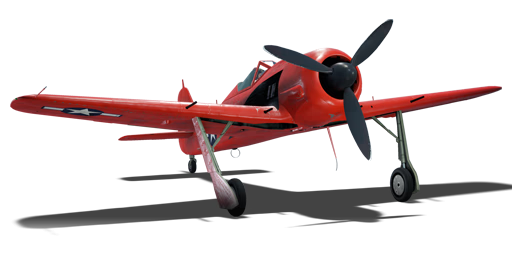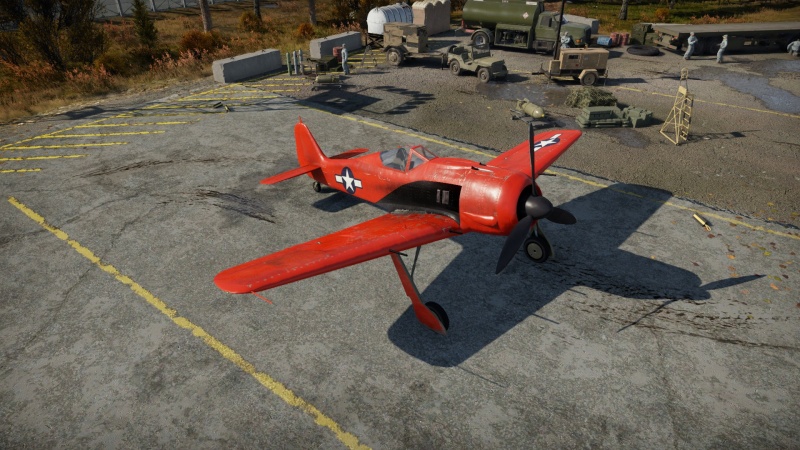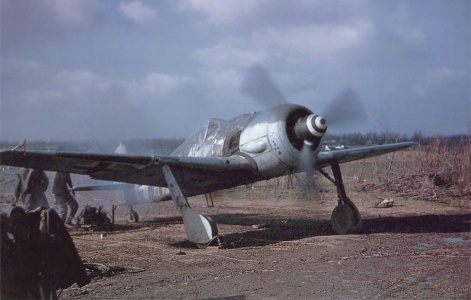Fw 190 A-8 (USA)
| This page is about the premium fighter Fw 190 A-8 (USA). For other versions, see Fw 190 (Family). |
Contents
Description
On January 1st, 1945, the Germans launched Operation Bondenplatte as an attempt by the Luftwaffe to destroy Allied airfields within the vicinity of the Low Countries in order to establish air superiority. Jagdgeschwader 4, with 75 Fw 190 A-8s, flew as part of this operation. During the operation, Colonel Walter Wagner's aircraft was damaged and was forced to make an emergency landing at the American-controlled St. Trond airfield, where the plane was captured. The Americans were able to repair the aircraft to running condition and repainted the aircraft in a red color and with American markings for a test flights.
Introduced in Update 1.43, this aircraft is an American-captured version of the Fw 190 A-8, sporting its own special red color paint job and American markings to distinguish from other Fw 190s. Unlike the German Fw 190 A-8, this American Fw 190 A-8 does not have provisions to mount ordnance, and as such only has its cannons for attack. Otherwise, the Fw 190 A-8 can be used all the same as a heavily-armed aircraft to gun enemy aircraft down.
General info
Flight performance
| Characteristics | Max Speed (km/h at 5,500 m) |
Max altitude (metres) |
Turn time (seconds) |
Rate of climb (metres/second) |
Take-off run (metres) | |||
|---|---|---|---|---|---|---|---|---|
| AB | RB | AB | RB | AB | RB | |||
| Stock | 622 | 602 | 10300 | 24.1 | 25.0 | 9.7 | 9.7 | 450 |
| Upgraded | 687 | 652 | 21.5 | 22.8 | 20.0 | 14.1 | ||
Details
| Features | ||||
|---|---|---|---|---|
| Combat flaps | Take-off flaps | Landing flaps | Air brakes | Arrestor gear |
| X | ✓ | ✓ | X | X |
| Limits | ||||||
|---|---|---|---|---|---|---|
| Wings (km/h) | Gear (km/h) | Flaps (km/h) | Max Static G | |||
| Combat | Take-off | Landing | + | - | ||
| 912 | 310 | N/A | 700 | 310 | ~13 | ~6 |
| Optimal velocities (km/h) | |||
|---|---|---|---|
| Ailerons | Rudder | Elevators | Radiator |
| < 420 | < 300 | < 550 | > 320 |
| Compressor (RB/SB) | ||
|---|---|---|
| Setting 1 | ||
| Optimal altitude | 100% Engine power | WEP Engine power |
| 1,500 m | 1,677 hp | 1,971 hp |
| Setting 2 | ||
| Optimal altitude | 100% Engine power | WEP Engine power |
| 5,900 m | 1,478 hp | 1,804 hp |
Survivability and armour
- 6 mm Steel - Fore cowl ring
- 10 mm Steel - Cowl ring
- 6 mm Steel - Under engine armour
- 8 mm Steel - Under cockpit/fuel tank armour plate
- 5 mm Steel - Rear fuel tank armour
- 8 mm Steel - Pilot's chair armour
- 6 mm Steel - Pilot's chair armour
- 12 mm Steel - Headrest armour
- 57 mm Bulletproof glass
Modifications and economy
Armaments
Offensive armament
The Fw 190 A-8 (USA) is armed with:
- 4 x 20 mm MG 151 cannons, wing-mounted (250 + 140 rpg each wing = 780 total)
- 2 x 13 mm MG 131 machine guns, nose-mounted (400 rpg = 800 total)
Usage in battles
The Fw 190 A-8 possesses far below average speed, acceleration, and climb ability for its rank. It does, however, have great high-speed control and a wicked armament that will shred any fighter almost instantly. It is recommended that you climb to the side and let your teammates engage first so you can put your excellent BnZ ability to work. If you spot a bandit co-alt, a head-on attack followed by an evasive manoeuvre and then extending away to repeat the processes is a recommended tactic. If a bandit has superior energy and is pressing an attack against you, try to drag them to friendlies, but don't sacrifice too much energy to do so. If you are skilled enough, another tactic would be to initiate a scissors; either rolling or flat, and then break away when he goes to yo-yo to control his overshoot. The scissors is a highly effective manoeuvre in the 190 A-8. If you are ballsy enough to press for a gun solution when scissoring an enemy, you could be greatly rewarded. In summary, climb to the side, Boom & Zoom like a champ, never get in a sustained turn fight, and use your rate of roll to free yourself when cornered.
Specific enemies worth noting
The premium Fw 190 A-8 sits at a high battle rating, close to the Spitfire LF Mk. IX and La-7B-20, both of which are vastly superior planes overall. It frequently faces Tempests, Fw 190 A-5, Bf 109 G-10 variants, Griffon Spitfires and F4U-1C's. Unfortunately, the A-8 is by large worse than all of these planes, but it still possesses some unique advantages and if piloted correctly is really going to give anyone trouble. However, these advantages are quite predictable and easily nullified by an attentive opponent.
Manual Engine Control
| MEC elements | ||||||
|---|---|---|---|---|---|---|
| Mixer | Pitch | Radiator | Supercharger | Turbocharger | ||
| Oil | Water | Type | ||||
| Not controllable | Controllable Auto control available |
Not controllable Not auto controlled |
Controllable Not auto controlled |
Combined | Not controllable 2 gears |
Not controllable |
Pros and cons
Pros:
- Very strong 4 x 20 mm MG 151 cannons
- Great roll rate
- Great energy retention
- Heavy armament
- Wide track landing gear makes landing easier
- Plenty of ammo
- Well armoured from the front
Cons:
- Large, slow turn rate combined with no combat flaps greatly reduces dogfight efficiency
- Elevator has low responsibility & effect on low-medium speeds
- Manoeuvrability at low speeds is bad
- Bad climb rate for a 190
History
On January 1, 1945, an Fw 190 A-8 (W.Nr. 681497) flown by Corporal Walter Wagner from 4./JG 4 landed at the allied-held field at St Trond, Belgium, after having been hit by flak and being forced to make an emergency landing during Operation Bodenplatte. From here it was transferred to the 404th Fighter Group, USAAF.[1][2] It was later repainted.
Media
- Skins
- Images
See also
- Related development
External links
References
| Focke-Wulf Aircraft Corporation (Focke-Wulf Flugzeugbau Aktiengesellschaft) | |
|---|---|
| Fighters | Fw 190 A-1 · Fw 190 A-4 · Fw 190 A-5 · Fw 190 A-5/U2 · Fw 190 A-5/U12 · Fw 190 A-5/U14 · Fw 190 A-8 |
| Fw 190 C | |
| Fw 190 D-9 · Fw 190 D-12 · Fw 190 D-13 | |
| Fw 190 F-8 | |
| Ta 152 C-3* · Ta 152 H-1* · Ta 154 A-1* | |
| Bombers | Fw 189 A-1 · Fw 200 C-1 |
| Export | ▅Fw 190 A-5 |
| Captured | ▃Fw 190 A-8 · ▂Fw 190 D-9 |
| * In 1944, the Germany Air Ministry changed new fighter aircraft designation to that of the chief designer. Kurt Tank was the chief designer at Focke-Wulf and later aircraft he designed were given the prefix of Ta. | |
| USA fighters | |
|---|---|
| P-26 Peashooter | P-26A-33 · P-26A-34 · P-26A-34 M2 · P-26B-35 |
| P-36 Hawk | P-36A · Rasmussen's P-36A · P-36C · ○P-36C · P-36G |
| P-39 Airacobra | P-400 · P-39N-0 · P-39Q-5 |
| P-40 | P-40C · P-40E-1 · P-40E-1 TD · P-40F-10 |
| P-43 Lancer | P-43A-1 |
| P-47 Thunderbolt | P-47D-22-RE · P-47D-25 · P-47D-28 · P-47M-1-RE · ⋠P-47M-1-RE · P-47N-15 |
| P-51 Mustang | P-51 · P-51A (Thunder League) · P-51C-10 · P-51D-5 · P-51D-10 · P-51D-20-NA · P-51D-30 · P-51H-5-NA |
| P-63 Kingcobra | P-63A-5 · P-63A-10 · P-63C-5 · ␠Kingcobra |
| Prototypes | XP-55 |
| F2A Buffalo | F2A-1 · Thach's F2A-1 · F2A-3 |
| BF2C | BF2C-1 |
| F3F | F3F-2 · Galer's F3F-2 |
| F4F Wildcat | F4F-3 · F4F-4 |
| F4U Corsair | F4U-1A · F4U-1A (USMC) · F4U-1D · F4U-1C · F4U-4 · F4U-4B · F4U-4B VMF-214 · F2G-1 |
| F6F Hellcat | F6F-5 · F6F-5N |
| F8F Bearcat | F8F-1 · F8F-1B |
| Other countries | ▃Ki-43-II · ▃Ki-61-Ib · ▃A6M2 · ▃Bf 109 F-4 · ▃Fw 190 A-8 · ▃Spitfire LF Mk IXc |
| USA premium aircraft | |
|---|---|
| Fighters | Thach's F2A-1 · Galer's F3F-2 · F2G-1 · F4U-4B VMF-214 · P-26A-34 · P-40C · P-43A-1 |
| P-47M-1-RE · ⋠P-47M-1-RE · P-51A · P-51D-10 · P-51D-20-NA · ␠Kingcobra · XP-55 | |
| ▃A6M2 · ▃Ki-43-II · ▃Ki-61-Ib · ▃Bf 109 F-4 · ▃Fw 190 A-8 · ▃Spitfire LF Mk IXc | |
| Twin-engine fighters | XP-38G · Bong's P-38J-15 · P-38K · YP-38 · P-61A-11 · XF5F · XP-50 · F7F-3 |
| Jet fighters | P-59A · F-86F-35 · F-89B · F-89D · F-4S Phantom II · F-5C · F-20A |
| Strike aircraft | A-1H · A2D-1 · AU-1 · XA-38 · AV-8A · A-6E TRAM · A-10A |
| Bombers | A-26C-45DT · B-10B · BTD-1 · PBM-3 "Mariner" · PV-2D |






